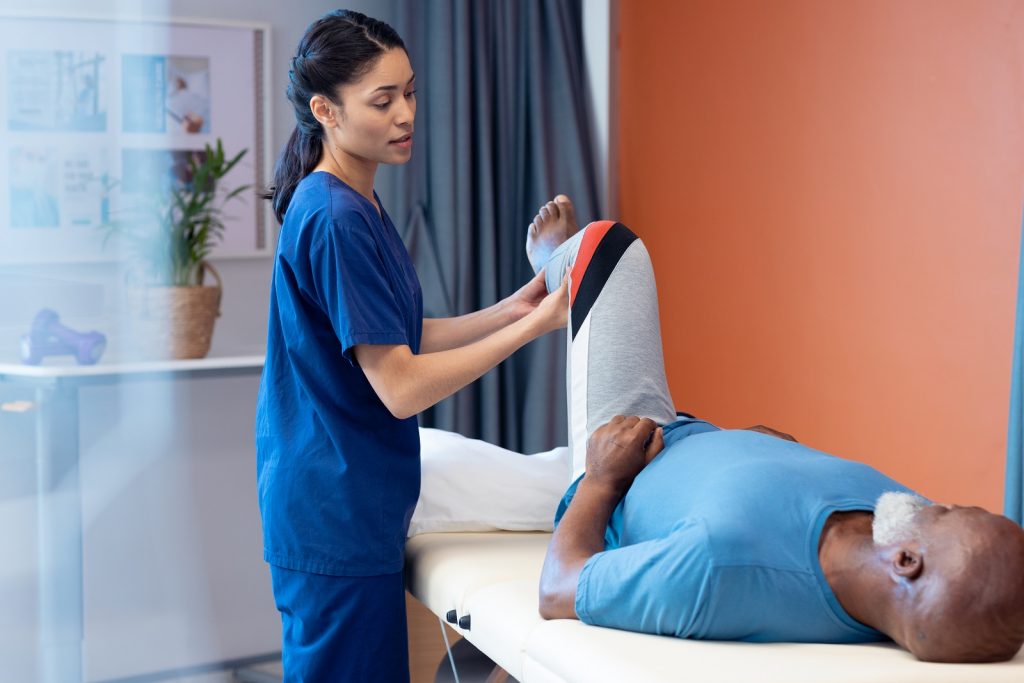ACL Rehabilitation: Comprehensive Guide to Recovery
Anterior cruciate ligament (ACL) rehabilitation is a critical process for individuals recovering from ACL injuries or surgeries. Proper rehabilitation ensures that patients regain strength, stability, and functionality in their knee, allowing them to return to their daily activities and sports with confidence.
This page provides an overview of the causes, symptoms, diagnosis, treatment options, and preventive measures associated with ACL injuries, as well as detailed information on the rehabilitation process.
Symptoms of ACL Injuries
Common symptoms include:
- Severe Pain: Immediate pain following an injury, often accompanied by a popping sound.
- Swelling: Rapid swelling within a few hours of the injury.
- Instability: A feeling of the knee giving way or buckling during movement. ● Loss of Range of Motion: Difficulty in bending or straightening the knee. ● Tenderness: Sensitivity around the knee joint, particularly along the ACL.

Diagnosis of ACL Injuries
Diagnosis typically involves:
● Medical History: A review of the patient’s injury history and symptoms. ● Physical Examination: Assessing knee stability, range of motion, and pain response. ● Imaging Tests: MRI scans are commonly used to confirm the presence and extent of ACL tears, while X-rays help rule out bone fractures.
Causes of ACL Injuries
ACL injuries, involving the tearing or over-stretching of the anterior cruciate ligament in the knee, can result from various factors. Understanding these causes is essential for both prevention and treatment.
Sports Activities:
- High-impact sports: Activities like football, basketball, and soccer frequently lead to ACL injuries. These sports involve high-intensity actions such as jumping, sudden stops, and rapid changes in direction. The dynamic nature and physical demands of these sports place significant stress on the knee joint, increasing the risk of ACL tears.
- Contact and non-contact scenarios: While contact sports can cause direct trauma to the knee, non-contact sports can also result in ACL injuries through abrupt movements that strain the ligament.
Direct Trauma
- Blows to the knee: Direct impact to the knee, such as during a tackle in football or a collision in basketball, can result in ACL injuries. These impacts can force the knee into unnatural positions, leading to ligament damage.
- Accidents: Car accidents or falls can also cause significant trauma to the knee, resulting in ACL tears. The sudden and forceful nature of these incidents can disrupt the ligament’s integrity.
Overextension
- Hyperextension: When the knee is straightened beyond its normal range of motion, the ACL can become overstretched and tear. This overextension can occur during activities that involve kicking, jumping, or awkward landings.
- Athletic maneuvers: Certain sports moves, such as high kicks or certain gymnastic routines, can lead to hyperextension injuries if not performed correctly. 4. Pivoting Movements:
- Rapid changes in direction: Activities that involve quick pivoting or twisting motions, particularly on a planted foot, can cause the ACL to tear. Sports like soccer, basketball, and tennis often require these rapid directional changes, placing the ligament at risk.
- Rotational forces: The rotational stress on the knee during these movements can exceed the ACL’s capacity to stabilize the joint, resulting in injury.
Improper Landing
- Jump landings: Landing awkwardly from a jump, especially with the knee extended or the foot turned, can place excessive stress on the ACL. This is common in sports like basketball, volleyball, and gymnastics.
- Impact absorption: Proper technique in landing is crucial to absorb the impact through the muscles rather than the ligaments. Improper landings can direct the force to the knee, increasing the risk of ACL tears.
Treatment Options for ACL Injuries
Treatment may include:
- Conservative Management: For partial tears or less active individuals, rest, physical therapy, and bracing may be recommended.
● Surgical Intervention: For complete tears or highly active individuals, ACL reconstruction surgery is often necessary. The procedure involves replacing the torn ligament with a graft.

Book an Appointment with Dr. Burhan
If you are experiencing knee pain or have suffered an ACL injury, feel free to book an appointment with Dr. Burhan for expert consultation and personalized treatment plans. Dr. Burhan’s extensive experience in sports medicine and orthopedic surgery ensures comprehensive care tailored to your specific needs.
By following a structured ACL rehabilitation program, patients can achieve optimal recovery and return to their active lifestyles. If you have any questions or need to schedule an appointment, please contact us. We’re here to help you every step of the way on your road to recovery.


